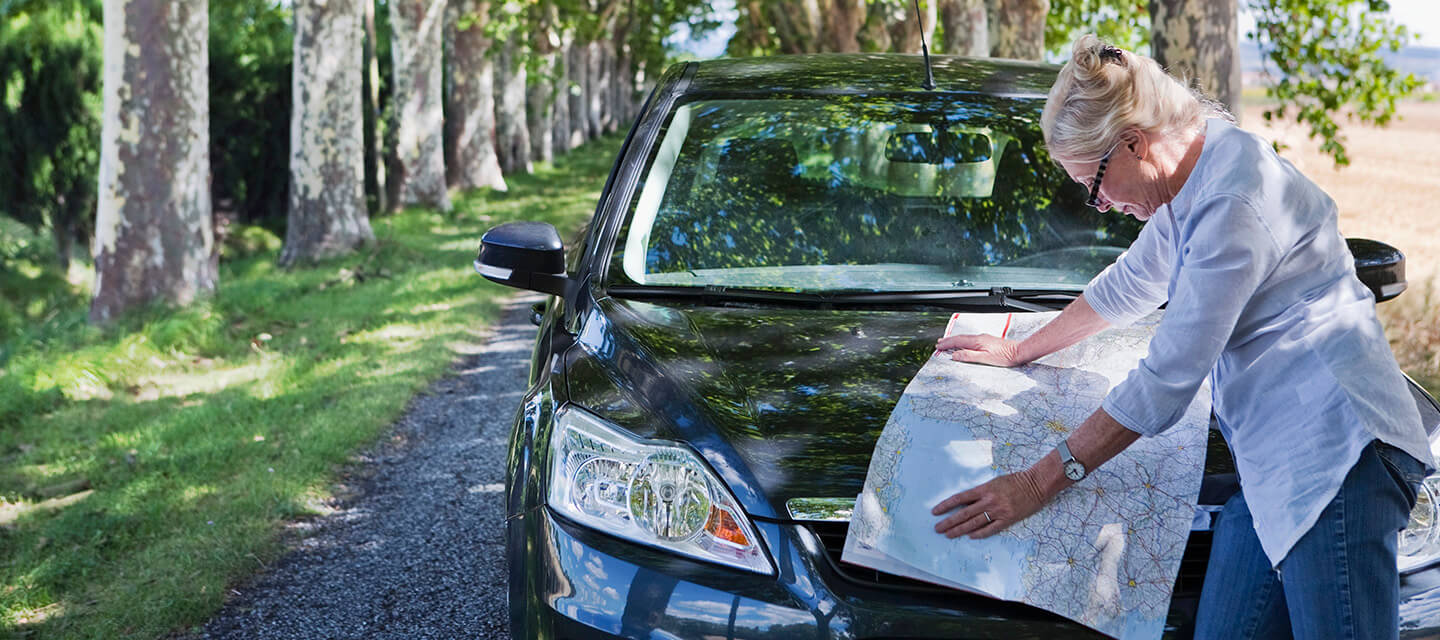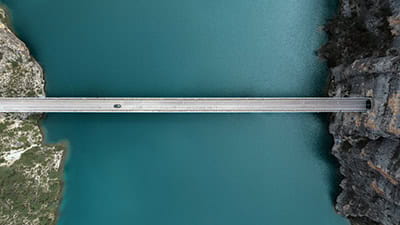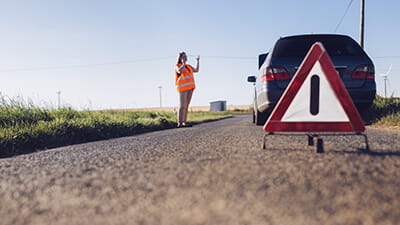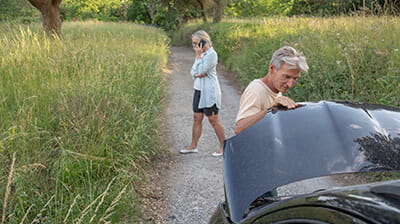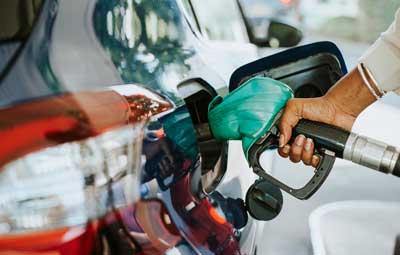Driving in Europe with European car insurance cover
If you’d like to take your car on holiday with you, it’s important to have the right European car insurance when you go. You’ll be pleased to know that, with Saga Car Insurance, you’re covered for trips within the EU for no extra cost. And if you’re planning to drive in the EU, you don't need to worry about getting a green card as they're no longer needed.
European car insurance cover for an unlimited period with Saga*
*Both Saga Select and Saga Plus cover levels include use of your car in over 30 European countries for an unlimited period of time. All drivers named on the policy are covered for driving in Europe, the policyholder doesn't have to travel with them.
Saga Standard also covers you for driving in Europe for up to 90 days in any policy year.
Saga Plus and Saga Select car insurance with unlimited European travel gives you the freedom to focus on your trip – however long you plan to be away. Check your policy documents to see exactly what European car insurance cover is included for your trips abroad.
Can I get car insurance with European breakdown cover?
To help keep you on the road, Saga Breakdown Assistance can be added to your Saga Car Insurance policy. Choosing the Premier option will give you European breakdown cover.
Saga Breakdown Assistance offers reliable breakdown cover 24 hours a day, 365 days a year and, with a range of cover levels, you can choose the cover that’s right for you. When travelling in the EU, you’ll have a maximum of five call outs.
Do I need a green card to drive in Europe?
You don't need a green card for driving in the EU anymore because the UK has joined the Green Card Free Circulation Area.
If you’re planning on driving in the EU, rest assured you’ll still be covered by your Saga policy with EU car insurance to drive in any of the countries that we cover as standard (listed in the table below).
What about outside the EU?
If you’re intending to drive elsewhere (such as Morocco, Tunisia, and Turkey) please give us a call on 0800 056 1472 as we may be able to provide a green card.
Follow these tips to keep the process simple:
- Be clear about your travel plans before contacting us – a green card will only be valid for a certain period and only in the countries listed on it.
- Request your green card about a month before you travel to make sure you get it in time.
- Once ordered, your green card should arrive in the post within seven working days.
- Your green card must cover the whole of your trip, and you’ll need to show it whenever you cross a country’s border.
- You must carry a paper copy – digital versions (like a PDF or photo on your phone) won’t be accepted.
We recommend keeping copies alongside your European car insurance policy documents so that you have everything you need to hand when you travel.
Do I need an international driving permit (IDP)?
An IDP is not generally required within Europe; however you may need one to drive in some EU countries and Norway if you have:
- a paper driving licence
- a licence that has been issued in Gibraltar, Guernsey, Jersey or the Isle of Man.
To check if you need an IDP to drive abroad, check the Gov.uk list. If you need an IDP, you can buy one over the counter at your local Post Office for a small fee. Together with your European car insurance you will then be able to drive anywhere within the EU.
Where am I covered to drive with Saga’s European car insurance?
Saga Car Insurance allows you to drive in over 30 European countries at no extra cost:
- Andorra
- Austria
- Belgium
- Bosnia and Herzegovina
- Bulgaria
- Croatia
- Czech Republic
- Denmark
- Estonia
- Finland
- France
- Germany
- Greece
- Hungary
- Iceland
- Italy
- Latvia
- Liechtenstein
- Lithuania
- Luxembourg
- Malta
- Monaco
- Montenegro
- Netherlands
- Norway
- Poland
- Portugal (inc. Madeira)
- Republic of Cyprus
- Republic of Ireland
- Romania
- San Marino
- Serbia
- Slovakia
- Slovenia
- Spain
- Sweden
- Switzerland
Following the UK’s withdrawal from the European Union on the 31 December 2020, the majority of protections that UK resident visitors to the EU benefit from remain in place, with the exception of Romania.
If you are visiting Romania you should be aware that if you are involved in an accident with an uninsured Romanian driver you will no longer be able to claim for compensation for personal injury via the UK MIB (Motor Insurance Bureau).
You will still benefit from all the core elements of your Saga Car Insurance policy (e.g. damage to your car), but any claim for compensation for personal injury would have to be pursued in Romania at your own expense and with no assistance from the MIB.
Romania is planning to re-instate its pre-Brexit position and support uninsured driver personal injury claims, but in the meantime, we advise you keep an eye on the Government's Driving in the EU page for up-to-date advice on this subject, or call us when you’re planning to travel to Romania and we will check the latest position for you.
More about Saga Car Insurance
Tips for driving in Europe
You might be an old hand at driving on the Continent, or maybe you’re planning your first trip with your car. Either way, it’s a good idea to be prepared before you start your journey. We’ve put together some tips for driving in Europe to get you on your way.
Familiarise yourself with the rules of the road
You wouldn’t go out onto the road in this country without having an understanding of the Highway Code so why would you do the same abroad? Research the rules of the road for the countries you plan to visit before you go so you know what to expect.
Make sure you can recognise common road signs and know what the speed limits are. Ignorance won’t be a very good defence if you get stopped by the police.
Did you know?
In many rural French towns, the priorité à droite (priority to the right) rule still exists. This means that cars coming out of side roads have priority over you when you’re driving down the main road! Be particularly careful and ready to brake while driving through these areas.
Remember to drive on the right-hand side of the road
The UK, Malta, Ireland and Cyprus are the only European countries that drive on the left. Everywhere else, they drive on the right-hand side of the road. You can buy a sticker to put on the windscreen or if you have a passenger ask them to remind you if it looks as though you’re going to get it wrong.
Driving on the other side of the road can be particularly hard to remember when it’s dark and there isn’t any other traffic.
Make sure your car maintenance is up-to-date
Be prepared for your journey abroad by carrying out some general checks on your car before leaving home.
- Check tyre pressures match the manufacturer’s recommendations – for some makes of car it might be recommended to alter the tyre pressures if your car is going to be particularly laden with people and luggage
- Check your tyre tread levels. The minimum tread differs across Europe so make sure your tyres will be legal.
- Check – and top up if necessary – your oil level, water level and screenwash.
- If your car’s annual service is due soon, it might be a good idea to have it serviced early, particularly if you have a long journey to complete.
What do I need to drive in Europe?
While driving abroad, you might be asked at any time to show your documents. You will be expected to be able to produce them immediately. Gather all your documents together and keep them in a safe place in your car.
-
Valid, full driving licence.
-
An International driving permit, if needed.
-
V5c – original registration document, not a photocopy.
-
Certificate that confirms you have European car insurance cover.
-
If you're travelling for more than 90 days you may need a visa or permit.
-
A UK sticker – you now need to display a UK identifier on your car when driving in Europe. This can either be a UK sticker or a number plate with the UK identifier and Union flag – unless you're travelling to Spain, Cyprus or Malta then you always need to display a UK sticker on your car. Check Gov.uk for full details.
-
Travel insurance documents.
-
Passports – make sure they’re valid for at least six months from your return date and are less than 10 years old.
You’ll definitely enjoy your trip more once you have all your documents including car and travel insurance for Europe sorted. For full details on what you need to drive in Europe, see the Government's driving abroad information.
Check for tolls, taxes and restricted-access schemes
Check what you need to do before driving on foreign roads. You may have heard about the London Congestion Charge and Low Emission Zone; many cities across Europe also operate schemes like these, and for most of them you will need to register and obtain stickers in advance. You can find a full list of all European environmental zones on the Green Zones portal. To prevent being caught out, and facing a hefty fine, make sure you do your research well before you go.
If you’re going to be driving on Swiss motorways you need to purchase and display a vignette sticker, which is car tax. Many motorways across Europe are toll roads so you’ll need to pay to drive on them. If you wish to avoid this, many sat-nav systems allow you to choose a route that avoids tolls – just be aware that this could make your journey much longer!
What do you need to carry in your car?
This is by no means an exhaustive list, please check the rules for the countries you're travelling to before you depart.
-
Reflective jackets – High visibility waistcoats are compulsory in most European countries. If you break down, you usually need to put them on before getting out of the car so you need to keep at least one inside the car at all times.
-
Headlamp beam converters – The rule is that you must not dazzle oncoming drivers. This doesn’t mean you have to use ‘beam benders’ but you must at least alter your lights so that they will not be dazzling. In some cars, you can do this at the switch of a button.
-
Warning triangle – This is compulsory in most countries, and in Spain, you need to have two triangles in case you break down – one for in front and one for behind the car.
-
Spare bulbs – In some countries you’re required to carry a spare bulb kit for your car so that if a light goes out, you can change it there and then.
-
First-aid kit – This is only compulsory in Austria but it’s recommended to keep a first-aid kit in your boot just in case.
-
Disposable breathalysers – You no longer need to carry a breathalyser kit, so taking one is optional. See this article on everything you need to know about driving in France for more information.
-
A spare pair of glasses – If you need to wear spectacles for driving, take a spare pair just in case your main pair gets broken or lost. This is especially important if you’re going to be the only one driving, and, if you’re driving in Portugal, it’s a legal requirement.
-
Snow chains or snow tyres – If you’re going to be driving during the winter, it may be necessary to have snow chains or winter tyres properly fitted.
Who are Saga's car insurance policies underwritten by?
Get a quote for Saga Car Insurance today
More from Saga Car Insurance
There's plenty to explore and learn about our car insurance cover.
